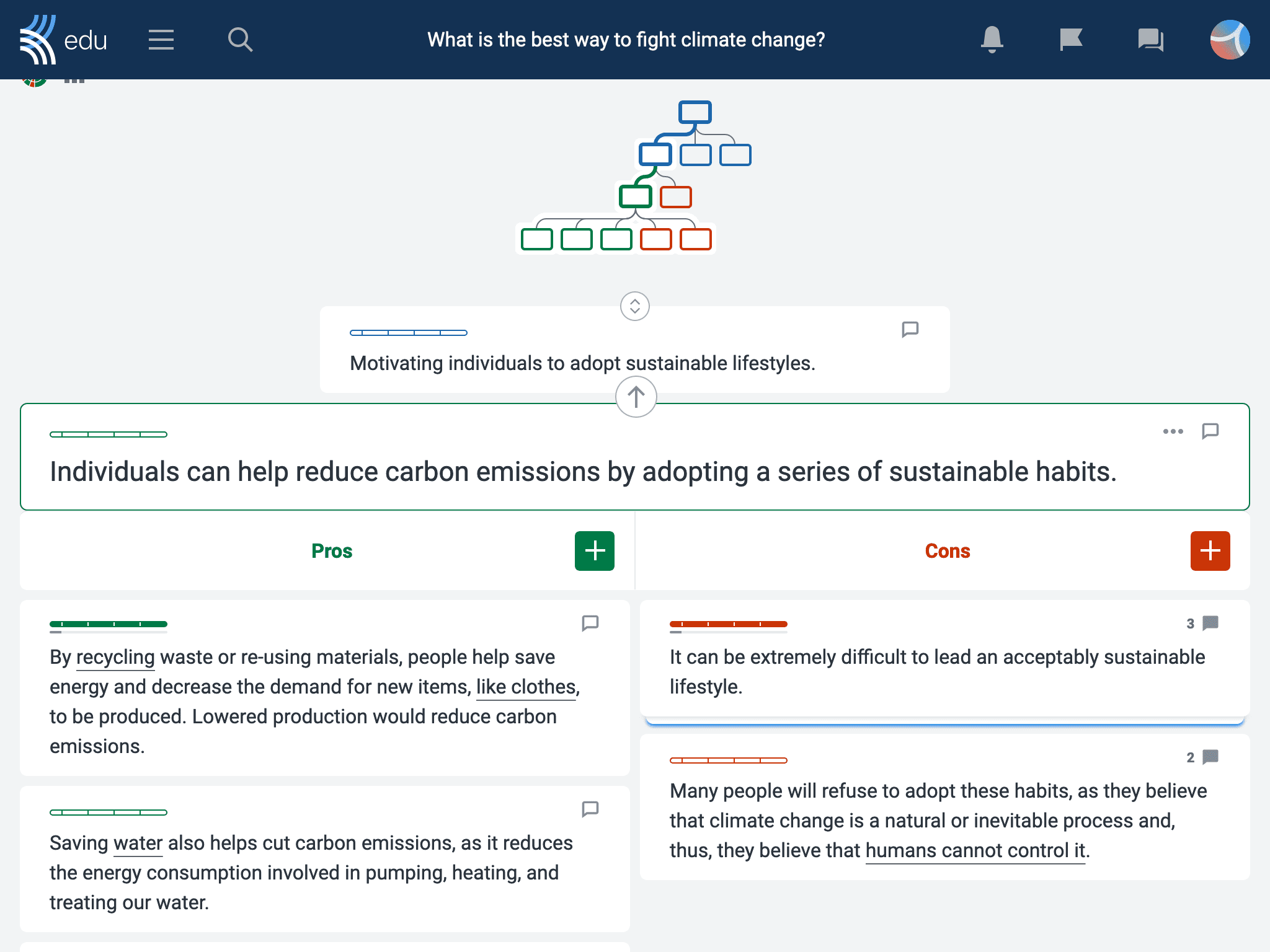A well-rounded education doesn’t just impart academic knowledge to students — it gives them transferable skills they can apply throughout their lives. Critical thinking is widely hailed as one such essential “21st-century skill,” helping people critically assess information, make informed decisions, and come up with creative approaches to solving problems.
Despite the widespread recognition of critical thinking’s importance for future success, there can be some ambiguity about both what it is and how to teach it. 1 Let’s take a look at each of those questions in turn, and explore how you can use Kialo Edu to teach critical thinking to students — completely free!
What is critical thinking?
Throughout history, humanity has attempted to use reason to understand and interpret the world. From the philosophers of Ancient Greece to the key thinkers of the Enlightenment, people have sought to challenge their preconceived notions and draw logical conclusions from the available evidence — key elements that gave rise to today’s definition of “critical thinking.”
At its core, critical thinking is the use of reason to analyze the available evidence and reach logical conclusions. Educational scholars have defined critical thinking as “reasonable reflective thinking focused on deciding what to believe or do,” 2 and “interpretation or analysis, followed by evaluation or judgment.” 3 Some have pared their definition down to simply “good” or “skillful thinking.”
At the same time, being a good critical thinker relies on certain values like open-mindedness, persistence, and intellectual humility. 4 The ideal critical thinker isn’t just skilled in analysis — they are also curious, open to other points of view, and creative in the path they take towards tackling a given problem.
Alongside teaching students how to analyze information, build arguments, and draw conclusions, educators play a key role in fostering the values conducive to critical thinking and intellectual inquiry. Students who develop both skills and values are well-placed to handle challenges both academically and in their personal lives.
Let’s examine some strategies to develop critical thinking skills and values in the classroom.
How to teach students to think critically — strategies
1. Build a classroom climate that encourages open-mindedness

Fostering a classroom culture that allows students the time and space to think independently, experiment with new ideas, and have their views challenged lays a strong foundation for developing skills and values central to critical thinking.
Whatever your subject area, encourage students to contribute their own ideas and theories when addressing common curricular questions. Promote open-mindedness by underscoring the importance of the initial “brainstorming” phase in problem-solving — this is the necessary first step towards understanding! Strive to create a classroom climate where students are comfortable thinking out loud.
Emphasize to students the importance of understanding different perspectives on issues, and that it’s okay for people to disagree. Establish guidelines for class discussions — especially when covering controversial issues — and stress that changing your mind on an issue is a sign of intellectual strength, not weakness. Model positive behaviors by being flexible in your own opinions when engaging with ideas from students.
2. Teach students to make clear and effective arguments
Training students’ argumentation skills is central to turning them into adept critical thinkers. Expose students to a wide range of arguments, guiding them to distinguish between examples of good and bad reasoning.
When guiding students to form their own arguments, emphasize the value of clarity and precision in language. In oral discussions, encourage students to order their thoughts on paper before contributing.

In the case of argumentative essays, give students plenty of opportunities to revise their work, implementing feedback from you or peers. Assist students in refining their arguments by encouraging them to challenge their own positions.
They can do so by creating robust “steel man” counterarguments to identify potential flaws in their own reasoning. For example, if a student is passionate about animal rights and wants to argue for a ban on animal testing, encourage them to also come up with points in favor of animal testing. If they can rebut those counterarguments, their own position will be much stronger!
Additionally, knowing how to evaluate and provide evidence is essential for developing argumentation skills. Teach students how to properly cite sources, and encourage them to investigate the veracity of claims made by others — particularly when dealing with online media.
3. Encourage metacognition — guide students to think about their own and others’ thinking
Critical thinkers are self-reflective. Guide students to think about their own learning process by utilizing metacognitive strategies, like learning journals or having reflective periods at the end of activities. Reflecting on how they came to understand a topic can help students cultivate a growth mindset and an openness to explore alternative problem-solving approaches during challenging moments.
You can also create an awareness of common errors in human thinking by teaching about them explicitly. Identify arguments based on logical fallacies and have students come up with examples from their own experience. Help students recognize the role of cognitive bias in our thinking, and design activities to help counter it.
Students who develop self-awareness regarding their own thinking are not just better at problem-solving, but also managing their emotions.
4. Assign open-ended and varied activities to practice different kinds of thinking
Critical thinkers are capable of approaching problems from a variety of angles. Train this vital habit by switching up the kinds of activities you assign to students, and try prioritizing open-ended assignments that allow for varied approaches. Students could explore how to build cities that don’t harm the environment or whether internet service should be nationalized.
A project-based learning approach can reap huge rewards. Have students identify real-world problems, conduct research, and investigate potential solutions. Following that process will give them varied intellectual challenges, while the real-world applicability of their work can motivate students to consider the potential impact their thinking can have on the world around them.

Classroom discussions and debates are fantastic activities for building critical thinking skills. As open-ended activities, they encourage student autonomy by requiring them to think for themselves.
They also expose students to a diversity of perspectives, inviting them to critically appraise these different positions in a respectful context. Class discussions are applicable across disciplines and come in many flavors — experiment with different forms like fishbowl discussions or online, asynchronous discussions to keep students engaged.
5. Use argument-mapping tools such as Kialo Edu to train students in the use of reasoning
One of the most effective methods of improving students’ critical thinking skills is to train them in argument mapping.
Argument mapping involves breaking an argument down into its constituent parts, and displaying them visually so that students can see how different points are connected. Research has shown that university students who were trained in argument mapping significantly out-performed their peers on critical thinking assessments. 5
While it’s possible — and useful — to map out arguments by hand, there are clear benefits to using digital argument maps like Kialo Edu. Students can contribute simultaneously to a Kialo discussion to collaboratively build out complex discussions as an argument map.

Individual students can plan essays as argument maps before writing. This helps them to stay focused on the line of argument and encourages them to preempt counterarguments. Kialo discussions can even be assigned as an essay alternative when teachers want to focus on argumentation as the key learning goal. Unlike traditional essays, they defy the use of AI chatbots like ChatGPT!
Kialo discussions prompt students to use their reasoning skills to create clear, structured arguments. Moreover, students have a visual, engaging way to respond to the content of the arguments being made, promoting interpretive charity towards differing opinions.
Best of all, Kialo Edu offers a way to track and assess your students’ progress on their critical thinking journey. Educators can assign specific tasks — like citing sources or responding to others’ claims — to evaluate specific skills. Students can also receive grades and feedback on their contributions without leaving the platform, making it easy to deliver constructive, ongoing guidance to help students develop their reasoning skills.
Improving students’ critical thinking abilities is something that motivates our work here at Kialo Edu. If you’ve used our platform and have feedback, thoughts, or suggestions, we’d love to hear from you. Reach out to us on social media or contact us directly at feedback@kialo-edu.com.
Footnotes
- Lloyd, M., & Bahr, N. (2010). Thinking Critically about Critical Thinking in Higher Education. International Journal for the Scholarship of Teaching and Learning, 4(2), Article 9. https://doi.org/10.20429/ijsotl.2010.040209
- Ennis, R. H. (2015). Critical Thinking: A Streamlined Conception. In: Davies, M., Barnett, R. (eds) The Palgrave Handbook of Critical Thinking in Higher Education. Palgrave Macmillan, New York.
- Lang-Raad, N. D. (2023). Never Stop Asking: Teaching Students to be Better Critical Thinkers. Jossey-Bass.
- Ellerton, Peter (2019). Teaching for thinking: Explaining pedagogical expertise in the development of the skills, values and virtues of inquiry. Dissertation, The University of Queensland. Available here.
- van Gelder, T. (2015). Using argument mapping to improve critical thinking skills. In The Palgrave Handbook of Critical Thinking in Higher Education (pp. 183–192). doi:10.1057/9781137378057_12.

